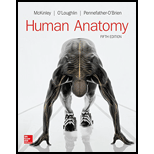
LooseLeaf for Human Anatomy
5th Edition
ISBN: 9781259285271
Author: Michael McKinley Dr., Valerie O'Loughlin, Elizabeth Pennefather-O'Brien
Publisher: McGraw-Hill Education
expand_more
expand_more
format_list_bulleted
Question
Chapter 1, Problem 9MC
Summary Introduction
Introduction:
The human body is composed of various types of bones and muscles. The thigh bone which is called femur is the largest, strongest, and the heaviest bone of the body. The bones and muscles of the body work together to cause movement of the body.
Expert Solution & Answer
Want to see the full answer?
Check out a sample textbook solution
Students have asked these similar questions
Hair follicle formation is thought to result from a reaction-diffusion mechanism with Wnt and its antagonist Dkk1. How is Dkk1 regulated by Wnt? Describe specific cis-regulatory elements and the net effect on Dkk1 expression.
Limetown S1E4 Transcript: E
n 2025SP-BIO-111-PSNT1: Natu
X
Natural Selection in insects
X
+
newconnect.mheducation.com/student/todo
CA
NATURAL SELECTION NATURAL SELECTION IN INSECTS (HARDY-WEINBERG LAW)
INTRODUCTION
LABORATORY SIMULATION
A Lab Data
Is this the correct allele frequency?
Is this the correct genotype frequency?
Is this the correct phenotype frequency?
Total
1000
Phenotype Frequency
Typica
Carbonaria
Allele Frequency
9
P
635
823
968
1118
1435
Color
Initial Frequency
Light
0.25
Dark
0.75
Frequency Gs
0.02
Allele
Initial Allele Frequency
Gs Allele Frequency
d
0.50
0
D
0.50
0
Genotype Frequency
Moths
Genotype
Color
Moths
Released
Initial
Frequency
Frequency G5
Number of
Moths Gs
NC
- X
Which of the following is not a sequence-specific DNA binding protein?
1. the catabolite-activated protein
2. the trp repressor protein
3. the flowering locus C protein
4. the flowering locus D protein
5. GAL4
6. all of the above are sequence-specific DNA binding proteins
Chapter 1 Solutions
LooseLeaf for Human Anatomy
Ch. 1 - Prob. 1WYLCh. 1 - How did the invention of movable type and...Ch. 1 - What is the relationship between anatomy and...Ch. 1 - Prob. 4WYLCh. 1 - Which level of organization consists of similar...Ch. 1 - Prob. 6WYLCh. 1 - Prob. 7WYLCh. 1 - If a physician makes an incision into a body...Ch. 1 - Prob. 9WYLCh. 1 - Use a directional term to describe the following:...
Ch. 1 - Match each numbered item with the most closely...Ch. 1 - Cutting a midsagittal section through the body...Ch. 1 - Examination of superficial anatomic markings and...Ch. 1 - Prob. 3MCCh. 1 - The state of maintaining a constant internal...Ch. 1 - Prob. 5MCCh. 1 - Which body cavity is located inferior to the...Ch. 1 - The term used when referring to a body structure...Ch. 1 - Which medical imaging technique uses modified...Ch. 1 - Prob. 9MCCh. 1 - The subdiscipline of anatomy that examines...Ch. 1 - Distinguish between cytology and histology.Ch. 1 - Prob. 2CRCh. 1 - Prob. 3CRCh. 1 - Prob. 4CRCh. 1 - Prob. 5CRCh. 1 - Prob. 6CRCh. 1 - Prob. 7CRCh. 1 - Prob. 8CRCh. 1 - Prob. 9CRCh. 1 - Describe which medical imaging techniques are best...Ch. 1 - If a person becomes ill and the symptoms indicate...Ch. 1 - Lynn was knocked off her bicycle during a race....Ch. 1 - Prob. 3DCR
Knowledge Booster
Learn more about
Need a deep-dive on the concept behind this application? Look no further. Learn more about this topic, biology and related others by exploring similar questions and additional content below.Similar questions
- Which of the following is not a DNA binding protein? 1. the lac repressor protein 2. the catabolite activated protein 3. the trp repressor protein 4. the flowering locus C protein 5. the flowering locus D protein 6. GAL4 7. all of the above are DNA binding proteinsarrow_forwardWhat symbolic and cultural behaviors are evident in the archaeological record and associated with Neandertals and anatomically modern humans in Europe beginning around 35,000 yBP (during the Upper Paleolithic)?arrow_forwardDescribe three cranial and postcranial features of Neanderthals skeletons that are likely adaptation to the cold climates of Upper Pleistocene Europe and explain how they are adaptations to a cold climate.arrow_forward
- Biology Questionarrow_forward✓ Details Draw a protein that is embedded in a membrane (a transmembrane protein), label the lipid bilayer and the protein. Identify the areas of the lipid bilayer that are hydrophobic and hydrophilic. Draw a membrane with two transporters: a proton pump transporter that uses ATP to generate a proton gradient, and a second transporter that moves glucose by secondary active transport (cartoon-like is ok). It will be important to show protons moving in the correct direction, and that the transporter that is powered by secondary active transport is logically related to the proton pump.arrow_forwarddrawing chemical structure of ATP. please draw in and label whats asked. Thank you.arrow_forward
- Outline the negative feedback loop that allows us to maintain a healthy water concentration in our blood. You may use diagram if you wisharrow_forwardGive examples of fat soluble and non-fat soluble hormonesarrow_forwardJust click view full document and register so you can see the whole document. how do i access this. following from the previous question; https://www.bartleby.com/questions-and-answers/hi-hi-with-this-unit-assessment-psy4406-tp4-report-assessment-material-case-stydu-ms-alecia-moore.-o/5e09906a-5101-4297-a8f7-49449b0bb5a7. on Google this image comes up and i have signed/ payed for the service and unable to access the full document. are you able to copy and past to this response. please see the screenshot from google page. unfortunality its not allowing me attch the image can you please show me the mathmetic calculation/ workout for the reult sectionarrow_forward
arrow_back_ios
SEE MORE QUESTIONS
arrow_forward_ios
Recommended textbooks for you
- Basic Clinical Lab Competencies for Respiratory C...NursingISBN:9781285244662Author:WhitePublisher:Cengage
 Medical Terminology for Health Professions, Spira...Health & NutritionISBN:9781305634350Author:Ann Ehrlich, Carol L. Schroeder, Laura Ehrlich, Katrina A. SchroederPublisher:Cengage Learning
Medical Terminology for Health Professions, Spira...Health & NutritionISBN:9781305634350Author:Ann Ehrlich, Carol L. Schroeder, Laura Ehrlich, Katrina A. SchroederPublisher:Cengage Learning

Basic Clinical Lab Competencies for Respiratory C...
Nursing
ISBN:9781285244662
Author:White
Publisher:Cengage



Medical Terminology for Health Professions, Spira...
Health & Nutrition
ISBN:9781305634350
Author:Ann Ehrlich, Carol L. Schroeder, Laura Ehrlich, Katrina A. Schroeder
Publisher:Cengage Learning


The Integumentary System, Part 1 - Skin Deep: Crash Course Anatomy & Physiology #6; Author: CrashCourse;https://www.youtube.com/watch?v=Orumw-PyNjw;License: Standard youtube license